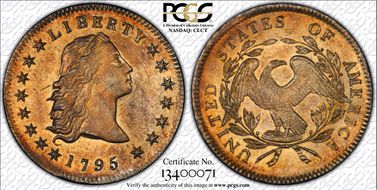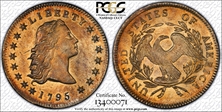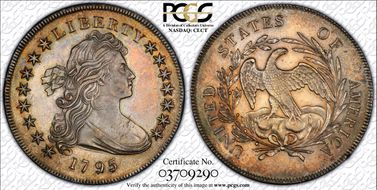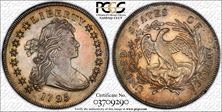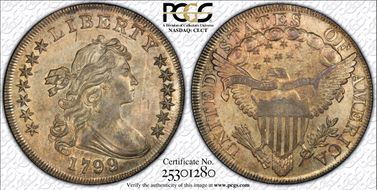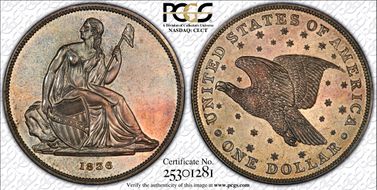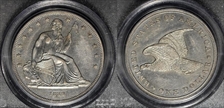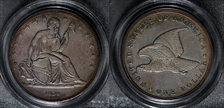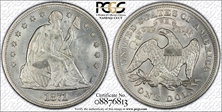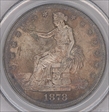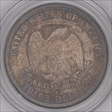Gobrecht's Raisinet Collection 的钱币相册
B-5, BB-27. R-1. An absolutely lovely coin, the visual appeal of which easily transcends its numerical grade. Delicately varying shades of golden toning aptly accent assertively struck, fully vibrant underlying surfaces. The fields exhibit an exceptionally atypical degree of reflectivity that only further heighten a bold strike. In fact, this extraordinary luster causes the viewer to look twice in case they have somehow confused this outstanding example with a Morgan dollar! Its visual allure surpasses most mint state survivors of this type.
B-5, BB-27. R-1. An absolutely lovely coin, the visual appeal of which easily transcends its numerical grade. Delicately varying shades of golden toning aptly accent assertively struck, fully vibrant underlying surfaces. The fields exhibit an exceptionally atypical degree of reflectivity that only further heighten a bold strike. In fact, this extraordinary luster causes the viewer to look twice in case they have somehow confused this outstanding example with a Morgan dollar! Its visual allure surpasses most mint state survivors of this type.
Top: PR58, Bot: PR45; 1839 PS$1 Name Omitted, Judd-104 Original, Pollock-116, R.3 Silver. Reeded Edge. Die Alignment IV, "original" issue of 1839. Mostly untoned. A bright and gleaming specimen whose mirrored luster seems poised to detonate like a Fourth of July skyrocket; and there is a touch of faint friction on the high points accounting for the conservative grade. More than adequately struck for the Type, these tend to show razor-sharpness on the shield, on Liberty's gown and hair, as well as on the eagle's body. A representative example of Gobrecht's artistic silver dollar masterpiece. As of April 2009, out of a PCGS population of only 18, these are two of just six 1939 proof silver dollars that PCGS has judged to be both original and "impaired" (i.e., circulated) proofs. The head of Liberty is nearly opposite the F in OF, and therefore is in Die Alignment IV orientation. A full figure of Liberty, with shield and Phrygian (“Liberty”) cap on a pole, is the main design element on the obverse. The 26 stars that had been placed on the reverse of the 1836 dollars have now been removed, and 13 stars are now seen around the figure of Liberty on the obverse. A majestic flying eagle (symbolizing the United States) adorns the reverse surrounded by the legend UNITED STATES OF AMERICA and the denomination: ONE DOLLAR. All of the 1839 dollars made in 1839 are thought to have been deposited into the US banking system. Therefore, by default, the Gobrecht dollars issued in 1839 are regular issued coins (even though they were struck in proof format). All Gobrecht dollars are assigned Judd numbers, suggesting that these coins are patterns. But this conclusion is not correct. In fact, the Gobrecht dollars made in 1836, 1837, and 1839 are regular issued coins, and therefore are not patterns. Nevertheless, for historical reasons, it appears that these coins will continue to be incorrectly identified as patterns. The only real Gobrecht dollar pattern coins are the Judd-58 (name below base) and the J-84 (1838 dollar). Gobrecht dollars represent a short, 3-year series, with two different "types" of coins. The first type consists of the issue of 1836 with the no-star obverse design, and the second type includes the 1838 and 1839 dollars with obverse stars but no reverse stars. Another interesting observation is that Gobrecht dollars are the only Proof coins intentionally made for general distribution. Gobrecht dollars are one of the most fascinating and yet confusing series of silver dollars ever made by the US Mint.
Top: PR58, Bot: PR45; 1839 PS$1 Name Omitted, Judd-104 Original, Pollock-116, R.3 Silver. Reeded Edge. Die Alignment IV, "original" issue of 1839. Mostly untoned. A bright and gleaming specimen whose mirrored luster seems poised to detonate like a Fourth of July skyrocket; and there is a touch of faint friction on the high points accounting for the conservative grade. More than adequately struck for the Type, these tend to show razor-sharpness on the shield, on Liberty's gown and hair, as well as on the eagle's body. A representative example of Gobrecht's artistic silver dollar masterpiece. As of April 2009, out of a PCGS population of only 18, these are two of just six 1939 proof silver dollars that PCGS has judged to be both original and "impaired" (i.e., circulated) proofs. The head of Liberty is nearly opposite the F in OF, and therefore is in Die Alignment IV orientation. A full figure of Liberty, with shield and Phrygian (“Liberty”) cap on a pole, is the main design element on the obverse. The 26 stars that had been placed on the reverse of the 1836 dollars have now been removed, and 13 stars are now seen around the figure of Liberty on the obverse. A majestic flying eagle (symbolizing the United States) adorns the reverse surrounded by the legend UNITED STATES OF AMERICA and the denomination: ONE DOLLAR. All of the 1839 dollars made in 1839 are thought to have been deposited into the US banking system. Therefore, by default, the Gobrecht dollars issued in 1839 are regular issued coins (even though they were struck in proof format). All Gobrecht dollars are assigned Judd numbers, suggesting that these coins are patterns. But this conclusion is not correct. In fact, the Gobrecht dollars made in 1836, 1837, and 1839 are regular issued coins, and therefore are not patterns. Nevertheless, for historical reasons, it appears that these coins will continue to be incorrectly identified as patterns. The only real Gobrecht dollar pattern coins are the Judd-58 (name below base) and the J-84 (1838 dollar). Gobrecht dollars represent a short, 3-year series, with two different "types" of coins. The first type consists of the issue of 1836 with the no-star obverse design, and the second type includes the 1838 and 1839 dollars with obverse stars but no reverse stars. Another interesting observation is that Gobrecht dollars are the only Proof coins intentionally made for general distribution. Gobrecht dollars are one of the most fascinating and yet confusing series of silver dollars ever made by the US Mint.
1871 Liberty Seated Dollar MS-63. Brilliant white, intensely frosty and choice for the grade. The blast of snow-white color comes with a change to more subtle frost on the main devices. The only weak area in the strike is seen at a few obverse stars.
1871 Liberty Seated Dollar MS-63. Brilliant white, intensely frosty and choice for the grade. The blast of snow-white color comes with a change to more subtle frost on the main devices. The only weak area in the strike is seen at a few obverse stars.
1871 Liberty Seated Dollar MS-63. Brilliant white, intensely frosty and choice for the grade. The blast of snow-white color comes with a change to more subtle frost on the main devices. The only weak area in the strike is seen at a few obverse stars.
1878-S T$1 MS64+. The 1878-S Trade dollar enjoyed a large mintage of 4.1 million pieces, and the date is readily available in most grades today. However, examples in Choice condition are scarce, and higher-grade pieces are rare. The present coin displays nice toning, with an iridescent violet and golden-brown patina, and ample frosty mint luster and sharply detailed devices.
1878-S T$1 MS64+. The 1878-S Trade dollar enjoyed a large mintage of 4.1 million pieces, and the date is readily available in most grades today. However, examples in Choice condition are scarce, and higher-grade pieces are rare. The present coin displays nice toning, with an iridescent violet and golden-brown patina, and ample frosty mint luster and sharply detailed devices.
A lustrous and virtually brilliant Premium Gem that boasts an exacting strike. A clean-cheeked and beautiful silver type coin.




















